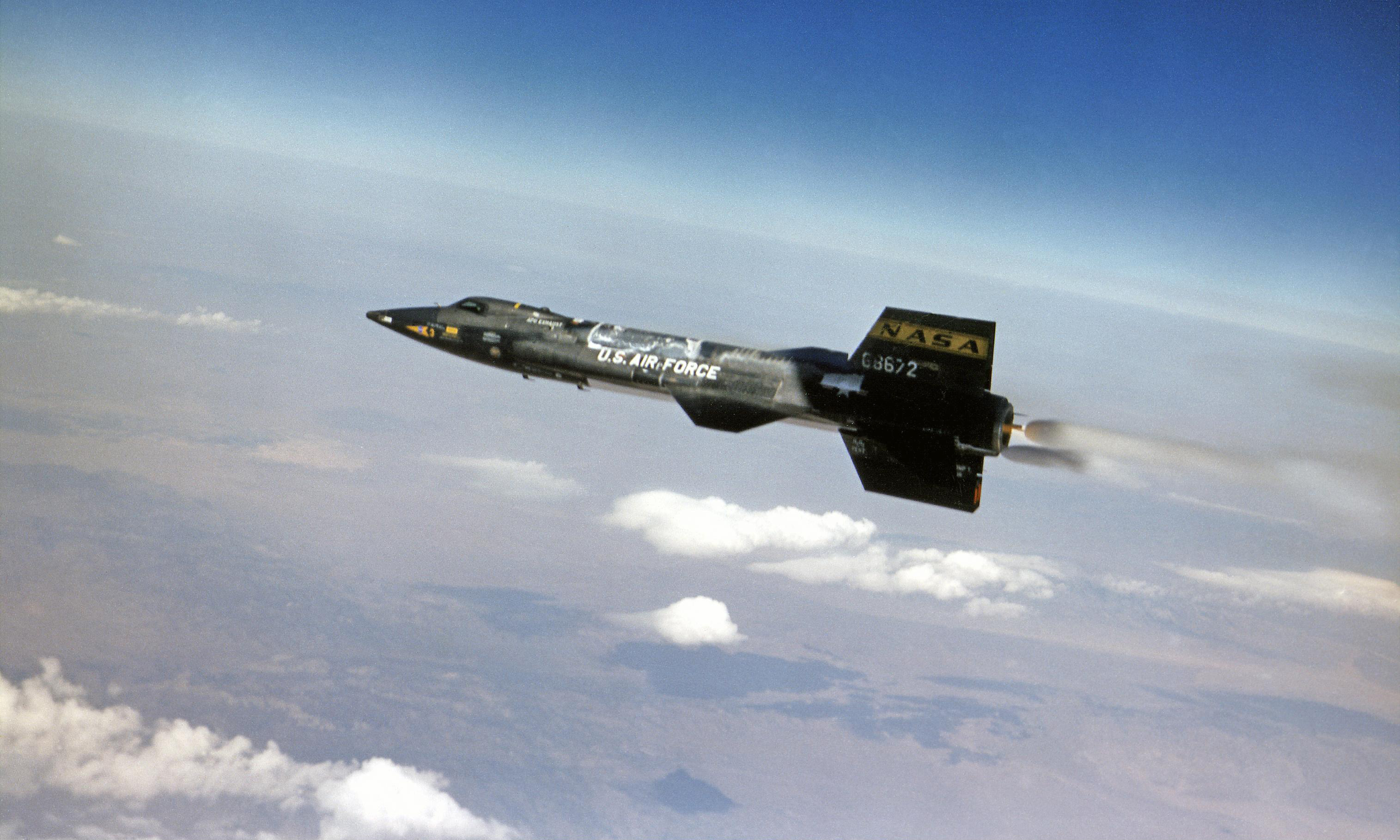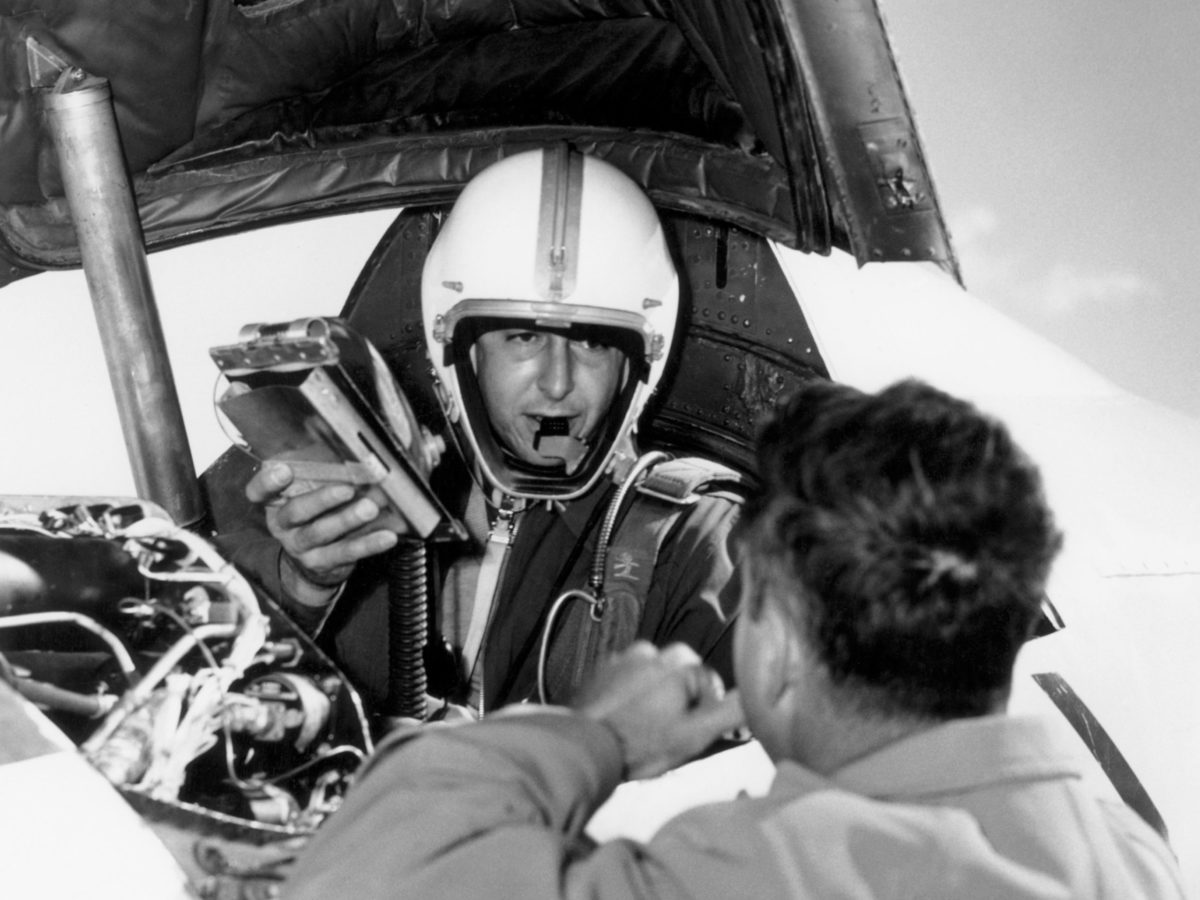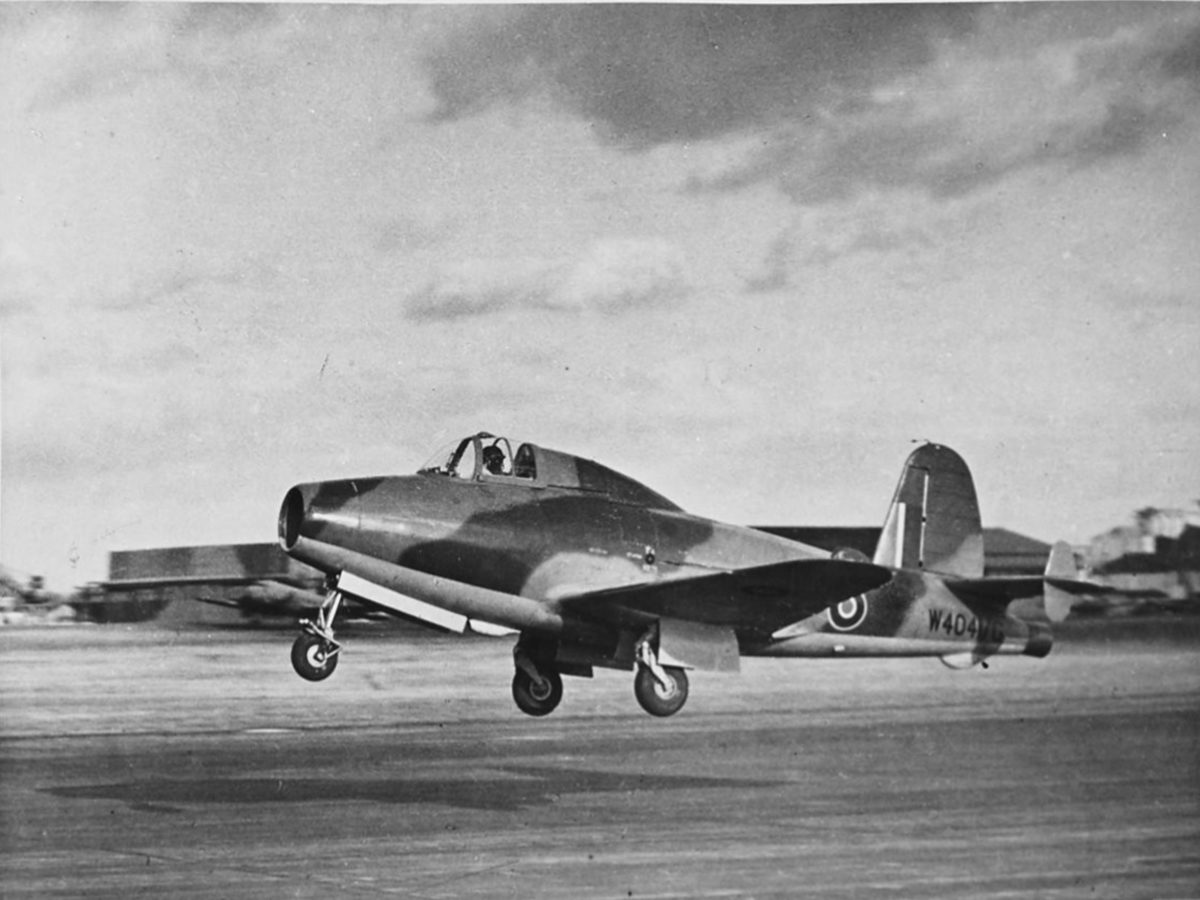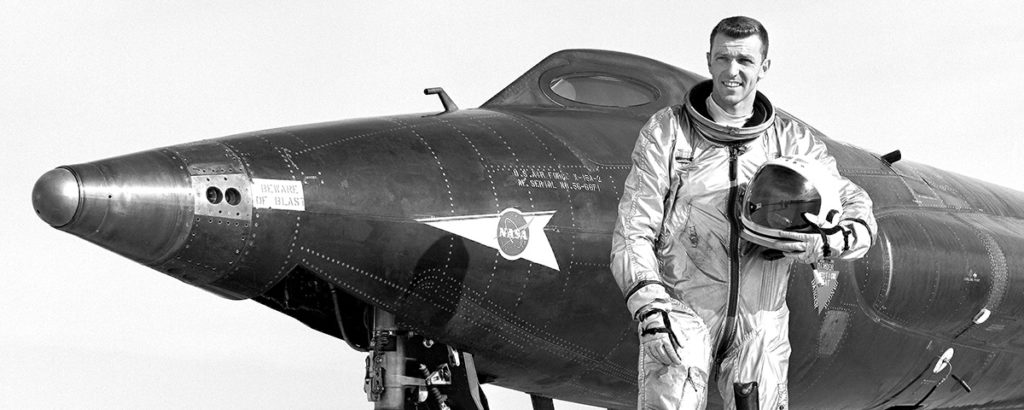The X-15 flew to speeds and altitudes never previously achieved by winged vehicles.
On the crisp, clear morning of November 9, 1961, a prospector working any of the many small mining claims in the bleak country around Mud Lake would have noticed the telltale broad white contrail signaling the approach of a strange formation of aircraft. If his eyesight was particularly acute, he might have discerned a giant Boeing NB-52B Stratofortress arrowing through Nevada’s dark blue sky, flanked by two sleek little fighters, a North American F-100 Super Sabre and a Lockheed F-104 Starfighter. As he watched, he might have seen a long black dart drop precipitously from the B-52, followed by the sudden boom and crackling rumble of an igniting rocket engine. Boosted by 60,000 pounds of thrust, it leapt ahead of the big bomber and its chase planes. Accelerating upward as it burned a ton of anhydrous ammonia and liquid oxygen every 12 seconds, it arced into the transatmosphere, its white exhaust trail pointing like a finger toward the future.
Not quite 90 seconds later, it was level at 102,000 feet, streaking toward Edwards Air Force Base in southern California at Mach 6.04, 4,094 mph. Air Force test pilot Major Robert White had just become the first man to take an airplane to Mach 6—six times the speed of sound—flying the second of three North American Aviation X-15 research airplanes. Slightly less than eight minutes and 200 miles later, trailed by another F-104 chase plane, the X-15, its propellants exhausted and now the world’s fastest glider, dropped in a steep curve to a landing flare and touchdown on Runway 18, marked out on the hard-baked clay of Rogers Dry Lake, the world’s largest natural landing site.
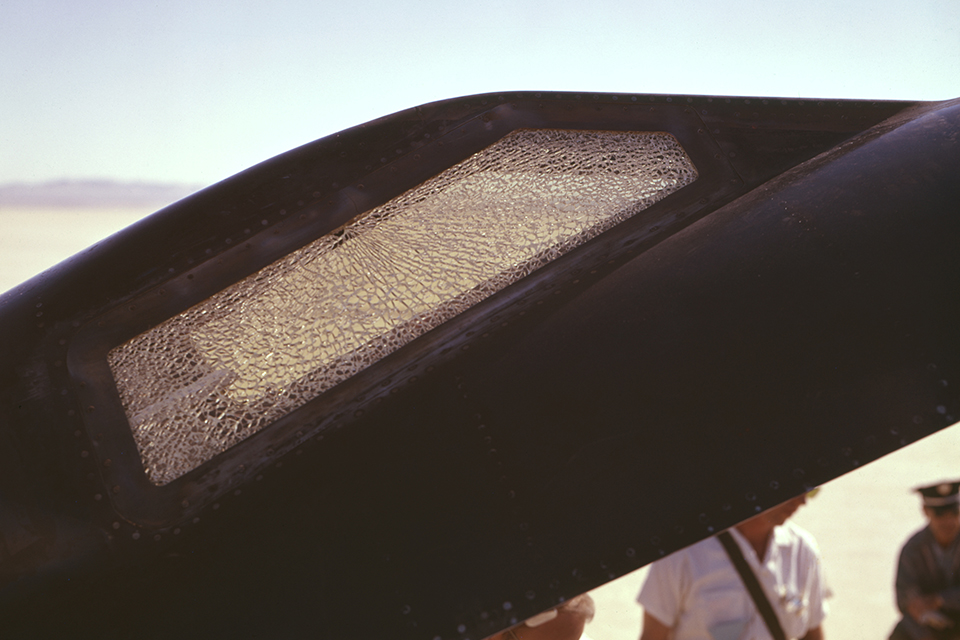
The X-15 program was a natural outgrowth of the progression of aviation since the time of the Wrights. The biplane had given way to the streamlined monoplane, and by the late 1930s the first experimental jet engines had appeared, promising an era of high-speed flight. But as an airplane flew closer to the speed of sound it encountered “compressibility,” the bunching up of air around it as it neared Mach 1, causing high drag, buffeting, changes in structural loads, and even loss of control and in-flight breakups. For more than a decade, until Chuck Yeager flew the first Bell XS-1 (later X-1) to Mach 1.06 in October 1947, it seemed that the speed of sound might indeed be a “barrier” to future flight. Afterward, aviation accelerated rapidly into the supersonic era: Mach 2 fell to Scott Crossfield and the second Douglas D-558-2 Skyrocket in November 1953, and Mach 3 to Captain Milburn Apt in the first Bell X-2 in September 1956 (though, tragically, he perished when the plane went out of control during its return to Edwards).
By the time of Apt’s death, the X-15 program was well underway. Its designers faced formidable challenges. Bell had built advanced variants of the X-1 that could exceed Mach 2 and 90,000 feet, and the sweptwing X-2 could climb above 125,000 feet. Both hinted at control challenges the X-15 would face. In 1956, when test pilot Captain Iven C. “Kinch” Kincheloe coasted to above 126,000 feet, his X-2 was like an artillery shell following a ballistic parabola. Near the top of its climb, as the plane decelerated after its rocket engine ran out of propellant, its ailerons, elevators and rudder were useless due to the very low dynamic pressure encountered as it passed through the upper atmosphere. The X-2 began a slow left roll, arced over the top of its ballistic parabola and, as its speed and, consequently, dynamic pressure increased in the lower atmosphere, its flight controls regained their effectiveness, and Kincheloe was able to guide it back to a safe landing on Edwards’ broad lakebed. Clearly, flying above 100,000 feet, future rocket planes would require reaction controls—small jet thrusters such as those employed on the first manned spacecraft—in addition to conventional aerodynamic control surfaces.
Aerodynamic heating and the high-altitude environment posed their own problems. Unlike supersonic flight, which is differentiated by the speed of sound and the distinctive crack of a sonic boom, hypersonic flight is characterized primarily by increasing aerodynamic heating, with intensely hot airflows and sharply angled shockwaves washing over the structure, their interactions producing even greater heat. The structure could not be conventional, for the plane would be subject to skin temperatures above 1,000 degrees Fahrenheit, necessitating extensive thermal protection. Inside the fully pressurized cockpit, the pilot would be more astronaut than airman, wearing a pressure suit and helmet capable of functioning in space-like conditions should cabin pressure be lost.
Interest in hypersonic flight predated the supersonic revolution. The three great prophets of the space age—Russia’s Konstantin Tsiolkovsky, the Romanian-German Hermann Oberth and America’s Robert Goddard—all advocated hypersonic airplanes as a means of flying into space, and German rocket enthusiast Max Valier, before his death in the explosion of an experimental rocket engine, recommended developing rocket-powered “ether planes” as intercontinental airliners. In the 1930s, Austrian engineer Eugen Sänger and mathematician Irene Bredt undertook the world’s first science-based hypersonic design, their so-called Silbervogel (Silver Bird). Proposed as a space transport and later as a global strike aircraft, it became an extraordinarily influential design study. Right after World War II, Joseph Stalin, according to a Soviet military defector, even sent a team into Western Europe on a fruitless mission to kidnap its authors, hoping that Soviet “Sänger planes” would “make it easier for us to talk to the gentleman-shopkeeper, Harry Truman.”
Higher, Faster, Farther
The combination of the Sänger-Bredt study and the example of the Nazi A-4 (V-2) ballistic missile greatly stimulated postwar American, Soviet and European interest in rockets, missiles and hypersonic aircraft. While the Sänger-Bredt study had been purely theoretical, the A-4 program had extensively studied Mach 4-plus winged derivatives, one of which, the A-4b, flew before war’s end, though it broke up during its terminal glide to earth. The Soviet-American race to develop atomic-armed ballistic missiles fostered heating and reentry studies, evolution of the “blunt body” reentry shape and high-temperature materials research. It also encouraged studies of rocket-boosted winged global-ranging hypersonic vehicles, even orbital spacecraft. In America, from all of this, sprang the X-15 and X-20 programs, though the latter never flew.
The roots of the X-15 reflected a broad base of military, industrial and governmental research support. In 1951 Robert Woods, Bell Aircraft Corporation’s chief engineer and a member of the National Advisory Committee for Aeronautics’ prestigious Aerodynamics Committee, called for development of a new research airplane with performance similar to the A-4’s. His continued pressure led NACA’s Executive Committee to endorse, a year later, investigating flight conditions between Mach 4 and Mach 10. The agency formed a hypersonic study committee under Langley Aeronautical Laboratory (now NASA Langley Research Center) engineer Clinton Brown, which subsequently advocated greatly expanded ground and flight test research using models and specialized test techniques. The committee even suggested modifying the X-2 with strap-on boosters to increase its performance above Mach 4, adding reaction controls for flight safety. (Program delays and the eventual loss of both airplanes doomed that idea.) In 1953 the Air Force’s Scientific Advisory Board concluded “the time is ripe” for a Mach 5-7 hypersonic vehicle, and the U.S. Navy’s Office of Naval Research issued a study contract to Douglas for a Mach 7-plus design tentatively designated the D-558-3. Air Force and Navy interest proved crucial to getting the X-15 program off the drawing board and into the air.
The next year, 1954, marked the genesis of the X-15. Another NACA study team, headed by John Becker, undertook preliminary design of a Mach 6 rocket-boosted hypersonic research airplane. It had a nickel-alloy Inconel structure, rocket-like four-fin tail and “off the shelf” rocket engines from the Hermes program. Becker’s study anticipated many of the X-15’s features and encouraged NACA that summer to invite the military services to join with it in developing such a craft. In October they formed the NACA–Air Force–Navy Research Aircraft Committee, subsequently known as the X-15 Committee. A joint program directive issued on December 23 gave technical oversight to NACA and design and construction authority to the Air Force. The Navy and Air Force would jointly fund the effort. Thus began “Project 1226,” the X-15.
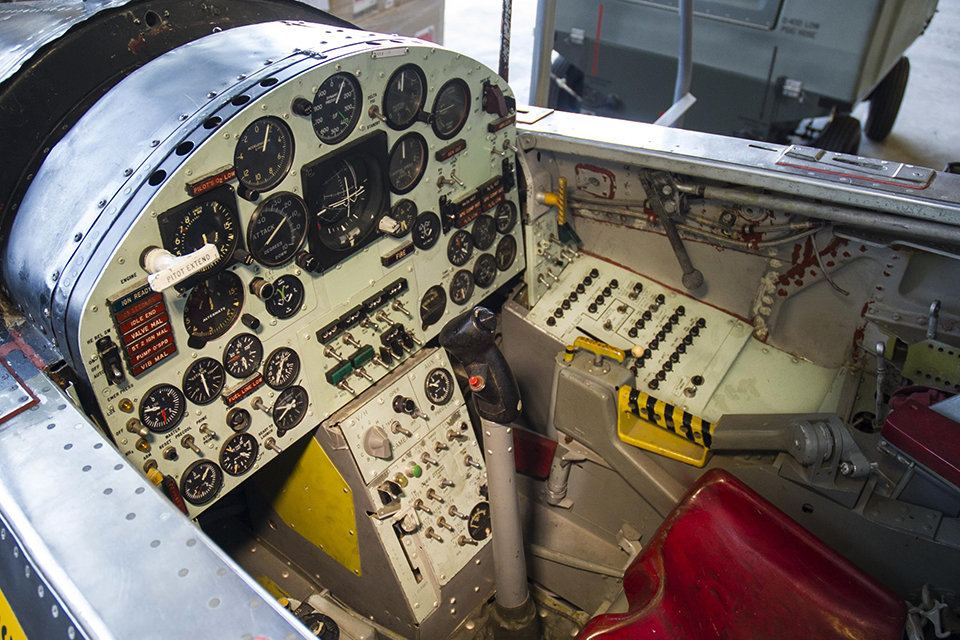
The Air Force supervised a design competition in 1955 between Bell, Douglas, North American and Republic. Bell’s Robert Woods, who had launched the company’s earlier X-1 effort, might reasonably have expected his firm to win, since it had already built and flown the X-1, X-2 and X-5. Douglas’ Ed Heinemann, with his D-558 Skystreak and Skyrocket (plus the D-558-3 study), might have as well. Both companies produced relatively cheap designs, each promising to deliver three airplanes for a total cost of $36 million. Harrison “Stormy” Storms, a veteran of North American’s many fighter programs, led the design team that drafted his firm’s entry—at an estimated $56 million, the most expensive proposal. But both the Bell and Douglas designs were considered too technically risky, and Republic’s, which was technically insufficient and also more costly than the Bell and Douglas proposals, came in last. Accordingly, despite the huge cost disparity, the Air Force notified North American on September 30 that it had won the competition. On June 11, 1956, after final negotiations, North American received a $42.9 million contract (about $349 million today) for the three X-15s. Three months later, Reaction Motors Inc. was awarded a $10.7 million contract for their engines.
The X-15 program involved far more than simply designing a new airplane, however novel it might be. Its rocket engine, pilot protection system, environmental controls and flight control system, as well as its flight test range, posed complex challenges.
The X-15’s XLR-99 engine, more than three times as powerful as the X-2’s and eight times as powerful as the X-1’s, proved particularly risky. Developed by New Jersey–based Reaction Motors (after April 1958 a division of Thiokol Chemical Corporation), the XLR-99 was based on the earlier XLR-30 used in the Navy’s Viking high-altitude rocket program. Any hopes that the Viking experience would help with its design proved illusory. Unlike the XLR-30, which burned diluted alcohol and liquid oxygen (“walc” and “lox” in rocket jargon), the 57,000-pound-thrust XLR-99 burned 1,445 gallons of more explosive anhydrous ammonia and 1,003 gallons of lox. More significant, however, Thiokol had to “man-rate” the engine, i.e., make it safe enough for operation in a piloted airplane, capable of repeated reuse, and both throttleable and restartable in flight. This was not easy to achieve, particularly as its high-speed turbopump, a potential source of disaster, fed the engine propellants at a rate of 167 pounds per second. Eventually, the XLR-99 became a reliable power plant, with a rated operational life of one hour (about 40 flights) before requiring overhaul. Such reliability came at the price of a far longer than anticipated development period, compelling North American to complete the first two X-15s with older XLR-11 engines (used on the X-1 more than a decade earlier) for their proving flights.
The X-15 required a complex flight control system. A conventional fighter-like stick controlled an all-moving tail that furnished pitch and roll control, but was used only during approach and landing. During high-G acceleration, climb-out and reentry, the pilot relied on a sidestick controller. A reaction control system operating small hydrogen peroxide jet thrusters located in the nose and wings furnished pitch, roll and yaw inputs at high altitudes, where conventional controls were ineffective. Eventually, the third X-15 flew with an adaptive flight control system that automatically compensated for changing dynamic pressure, blending the reaction control system with the conventional aerodynamic controls. Since the X-15 was technically a “boost-glider,” once it exhausted its propellants the pilot had to carefully manage his energy to ensure he could reach Rogers Dry Lake. To help in doing this, the X-15 would always be flown so that it had excess energy at burnout, which the pilot could (if necessary) bleed off using large petal-like speed brakes installed in the sides of the massive dorsal and ventral fins.
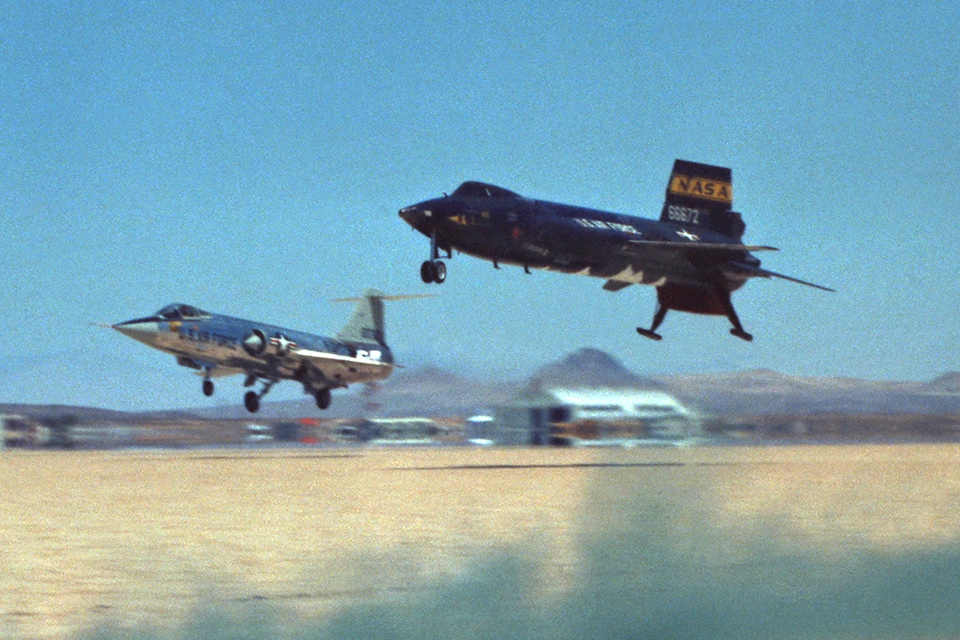
Unlike earlier rocket-powered aircraft that flew near Edwards AFB, the X-15 demanded a special flight test corridor, dubbed the “High Range,” running roughly 480 miles from Wendover, Utah, southwest to Edwards. Crossing multiple mountain ranges and the stark Southwestern desert, the High Range was itself a notable technical accomplishment, foreshadowing the manned spacecraft tracking network NASA established for Project Mercury several years later. NASA furnished two tracking stations, at Ely and Beatty, Nev., as well as at Edwards. Furthermore, unlike earlier research airplanes, the X-15 required a complex flight simulator to train pilots and undertake mission planning and rehearsal. The simulator was updated using data acquired during X-15 flights, with pilots typically spending 40-50 hours in it before undertaking a 10- to 12-minute flight.
When the program commenced, it was hoped the X-15 might be flying by the end of 1957. Due to the complexity of its design and the technical challenges involved, however, test flights did not begin until 1959. In the interim, NASA and the Air Force supported the X-15 development effort with extensive wind tunnel and free-flight ballistic tunnel testing, evaluated reaction controls on ground simulator rigs and on modified research airplanes including the Bell X-1B and an F-104, and undertook extensive simulation studies to prepare for the crucial challenges faced by a hypersonic rocket plane having, for its time, the lowest lift-to-drag ratio ever flown on a piloted aircraft.
In October 1957, Sputnik had seized the public imagination, and in the national debate over American science and technology that followed, NACA had given way to the space-focused NASA. Now the X-15 took on greater urgency and visibility as a symbol of America’s progression into space. Vice President Richard Nixon presided over its rollout at North American’s Los Angeles facility on October 15, 1958, a year after the Soviet satellite ushered in the space age.
It was a remarkable-looking craft—burnished metallic black, with thin wings and horizontal tail surfaces, and, because of the directional stability requirements of high-supersonic and hypersonic flight, large “meat cleaver” dorsal and ventral vertical fins, the lower half of the ventral surface jettisonable during landing approach so that the X-15’s landing skids could be a reasonable size. Although planners had originally thought the X-15 would use a modified Convair B-36 as a mothership, the retirement of the B-36 and the availability of the more powerful and capable B-52A led to its substitution for Convair’s giant intercontinental bomber.
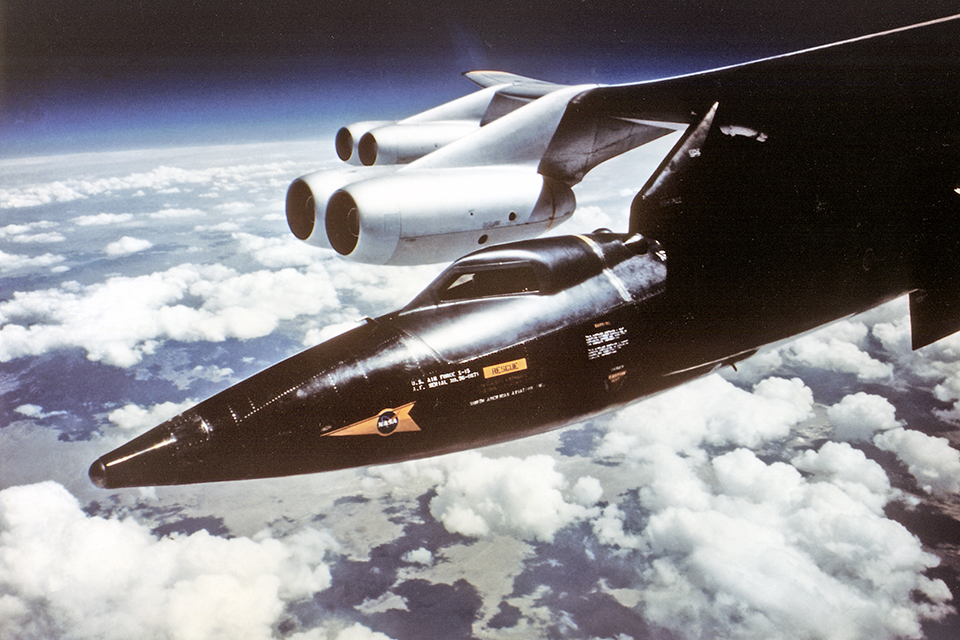
Early tests with the X-15 proved far from encouraging. Piloted by North American test pilot Scott Crossfield (who had been so dedicated to the project that, as it began, he left NACA for North American), the first X-15, AF 56-6670, made its maiden captive flight on March 10, 1959, followed by its first glide flight on June 8. During the landing approach, Crossfield encountered serious longitudinal control problems that pushed his piloting skills to the limit, necessitating adjustments to the boosted flight control system. The second X-15, AF 56-6671, made the type’s first powered flight on September 17. Propelled by two XLR-11 engines, it reached Mach 2.11 at 52,341 feet. He completed another powered flight in it to Mach 2.15 a month later, but then, on November 5, disaster struck when an engine fire forced an emergency landing on Rosamond Dry Lake, during which 6671 broke its back.
While the second X-15 returned to North American for repairs and installation of its XLR-99, proving flights continued through 1960 with 6670, still equipped with its interim XLR-11s. The third X-15, AF 56-6672, was the first completed with the big Thiokol XLR-99, but during an Edwards ground test the engine blew up, catapulting the rest of the airplane forward. Safe in its cockpit, Crossfield marveled at the X-15’s strength and worried for the safety of crews trying to extricate him. The plane, like the second X-15, returned to North American for a rebuild. Not until November 15, 1960, three years late, would the X-15 fly with its XLR-99 engine, when Crossfield took 6671 to Mach 2.97, marking the end of its contractor flight test program.
But now the X-15 hit its stride. On March 7, 1961, Air Force Major Robert M. White became the first pilot to exceed Mach 4. He piloted the second X-15 across the hypersonic divide on June 23, attaining Mach 5.27 (3,603 mph). White completed a sonic trifecta by exceeding Mach 6 on November 9, as previously mentioned. Nor was the boyish airman the X-15’s only record-setter. On August 22, 1963, NASA research pilot Joseph Walker attained 354,200 feet (67.08 miles) in the third X-15, taking it into space.
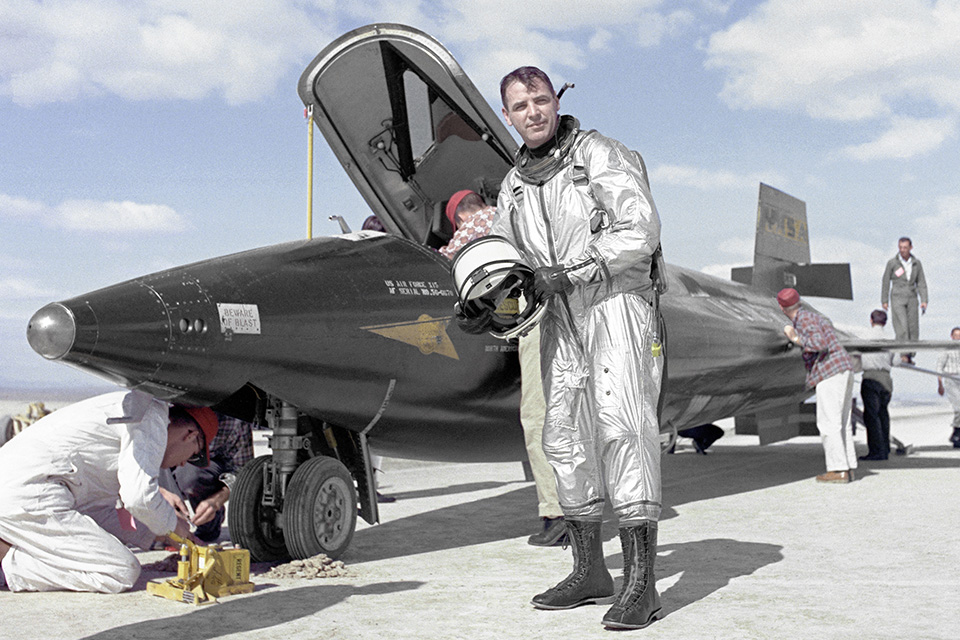
Marring this was a serious landing accident on November 9, 1962, that virtually destroyed the second X-15 and seriously injured NASA pilot Jack McKay. When an engine failure necessitated a heavyweight emergency landing on Mud Lake, 6671’s skid landing gear collapsed. Even this setback was turned to advantage, for NASA lengthened the X-15 and added provisions for two huge drop tanks and a dummy supersonic combustion ramjet (scramjet) engine installation on the shortened lower vertical fin. Eventually, on October 3, 1967, Major William J. “Pete” Knight reached Mach 6.7, 4,520 mph, flying this aircraft, designated the X-15A-2. During the flight, unanticipated heating led to multiple structural failures, causing the scramjet module to separate from the aircraft and damaging the fuel-jettison system. Knight, a superlative airman, landed safely.
Sadly, shortly after Knight’s remarkable flight—the fastest by a piloted airplane in the 20th century—Air Force test pilot Major Michael Adams was killed in the third X-15. On November 15, 1967, during a high-altitude flight, it entered a Mach 5-plus spin and then broke up well above Mach 4 during an inverted dive into the lower atmosphere. The accident stemmed from a fatal combination of instrumentation and control systems failures, plus human factors. Less than a year later, on October 24, 1968, the X-15 completed its last flight, its 199th, flown by NASA pilot William Dana. NASA attempted a 200th flight on December 20, but Edwards was untypically swathed in snow. Planners took it as an omen, and simply retired the craft. The first X-15 went to the National Air and Space Museum, where it may be seen in the Milestones of Flight gallery, and the second, the fastest airplane of the 20th century, to the National Museum of the U.S. Air Force.
Altogether 12 distinguished pilots—Scott Crossfield, Robert White, Forrest Petersen, Neil Armstrong, Joe Walker, Jack McKay, Milt Thompson, Robert Rushworth, Mike Adams, Bill Dana, Pete Knight and Joe Engle—had flown the X-15 to speeds and altitudes never previously achieved by winged vehicles. Its research program consisted of an aerodynamic and structural heating investigation phase from 1959 through 1963, and a follow-on program utilizing the X-15 to carry experiments into the upper atmosphere or to hypersonic speeds. Much of the applications program benefited the contemporaneous Apollo effort, but it also helped sensor and missile detection efforts. X-15 flights produced more than 700 technical reports, establishing a database still considered essential today, as hypersonics advances into the second century of flight.
The X-15 was by no means a perfect research vehicle. Under some circumstances it had dangerous flight characteristics, and heavy impact loads sorely taxed its landing skids. During reentry, in-flight resonance effects could interact with its flight control system. Early on, researchers discovered gaps in panels that permitted the entry of hot hypersonic air into its structure, necessitating fixes. Cockpit outer windowpanes shattered from heat-distorted panel frame structural loads, forcing redesign, and its nose landing gear twice extended in flight due to thermal stresses. There were several landing incidents and accidents, one major ground explosion (Scott Crossfield used to joke it constituted the X-15’s “200th flight”) and, of course, the sad loss of the third X-15 with Mike Adams.
But overall, as a product of the pre-computer design era, and without the benefit of modern tools such as computational fluid dynamics and computer-aided design and manufacturing, the X-15 constituted a remarkable achievement and an astonishingly productive research program, bridging the age of flight and the age of space. Fittingly, two of its most distinguished pilots went on to greater fame in the U.S. space program. Neil Armstrong became the first man to walk on the moon, and Joe Engle became one of NASA’s first space shuttle mission commanders. Today, Air Force and NASA researchers pursue Mach 6 hypersonic flight with the airbreathing Boeing–Pratt & Whitney–Rocketdyne X-51A WaveRider scramjet research vehicle. Tellingly, its designation—X-51—was deliberately chosen and reserved to echo the X-15 and remind researchers of the remarkable aircraft that, a half-century ago, did so much to make hypersonic flight a reality.
Richard P. Hallion is a former U.S. Air Force historian and the author of many books on aviation. For additional reading, he recommends: North American X-15/X-15A-2, by Ben Guenther, Jay Miller and Terry Panopalis; X-15: Extending the Frontiers of Flight, by Dennis R. Jenkins; and At the Edge of Space: The X-15 Flight Program, by Milton O. Thompson.
In 1971, as commercial aviation prepared to enter the era of the SST, John Becker and Frank Kirkham of NASA’s Langley Research Center assessed the possibility of hypersonic commercial airliners. They predicted that by 1995 Americans could be flying in a 750,000-pound Mach 6 delta-wing hypersonic transport (HST) carrying 300 passengers from Los Angeles to Paris in 2.7 hours (compared to 9.8 hours via a Mach 0.85 jetliner). Alas, today the HST remains just an intriguing possibility, while even the Concorde and Tu-144 SSTs have made their last landings, relegated to a few of the world’s aerospace museums at the end of 2003, the centennial of Kitty Hawk. NASA backed away from SST-HST studies in the mid-1990s, leading one agency historian, Erik Conway, to conclude speed is “no longer the unalloyed virtue that it had been in the 19th century.” Robert van der Linden, chair of the National Air and Space Museum’s Aeronautics Department, has said, “I think speed’s overrated.” Airline economist, historian and market analyst R.E.G. Davies damned speculation about SSTs and HSTs as “arrant nonsense.” In the wake of the impending retirement of the space shuttle, The Wall Street Journal’s Daniel Michaels concluded the world is nearing “The End of the Age of Speed.”But speed is more than merely an economic value or cheap thrill. It gives humanity the ability to travel and accomplish some end without wasting time in transit. Donald Douglas, whose shapely airliners redefined air transportation in the 1930s, wrote, “Time wasted in travel means money lost, suffering endured, or pleasure sacrificed.” Even Concorde’s passengers, for all the talk of jaded mega-celebrities, were people who had a real need for speed: surgeons, government officials, couriers, businessmen and the like—and it never flew empty. In May 2010, the aviation world caught a glimpse of the future when the Boeing X-51A WaveRider flew at nearly five times the speed of sound. Powered by a Pratt & Whitney–Rocketdyne scramjet engine burning JP-7 fuel, the X-51A climbed away from its B-52H launch ship, accelerating steadily on scram power. It constituted a “Kitty Hawk” moment, the first flight of a practical thermally balanced hydrocarbon scramjet engine, an accomplishment as significant to the history of flight propulsion as Frank Whittle’s and Hans von Ohain’s first experiments with gas turbines in the 1930s, which foretold the jet age revolution that followed. Humanity entered the 19th century at 6 mph, the 20th at 60 mph and the 21st at 600 mph. It is entirely possible, indeed probable, that this trend will continue, and humankind will enter the 22nd century at 6,000 mph, the speed of a hypersonic airliner. But if it is achieved, will it be an American accomplishment? That is the most intriguing question of all. —Richard P. Hallion 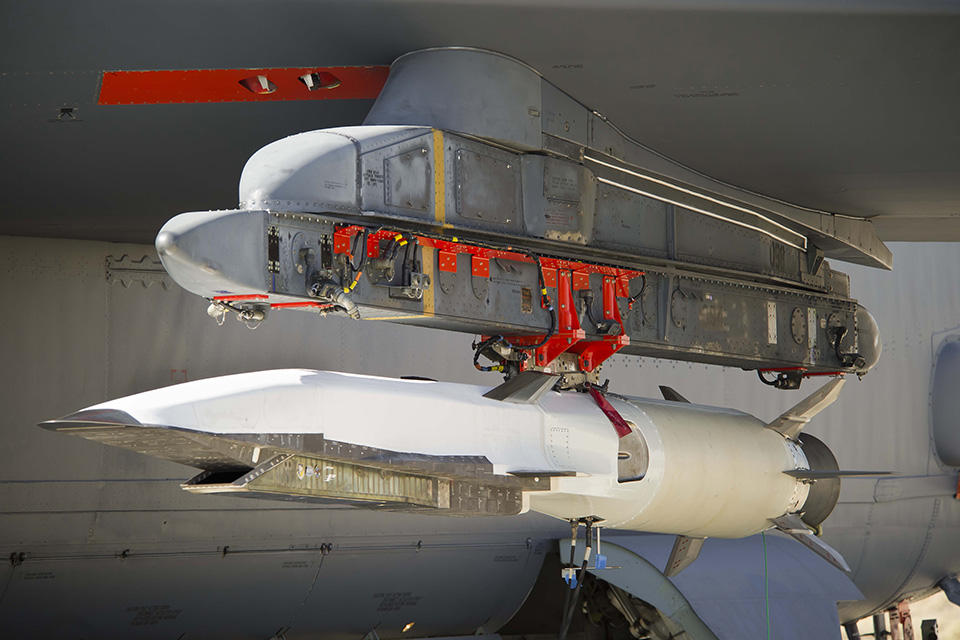
Build your own X-15A-2!
This feature originally appeared in the July 2012 issue of Aviation History Magazine. Subscribe today!
historynet magazines
Our 9 best-selling history titles feature in-depth storytelling and iconic imagery to engage and inform on the people, the wars, and the events that shaped America and the world.


